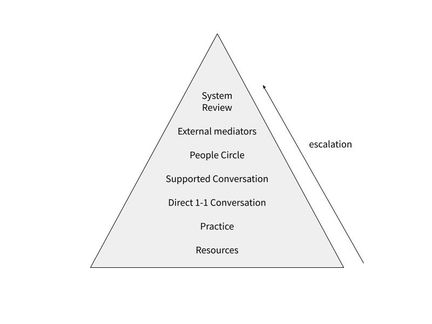Conflict resolution procedures
At Agile Collective we want to manage any conflict well. We want tensions between team members to be healthy and productive, part of a culture of open debate, honesty, and care – all in service of our mission.
Principles
- Resolve conflicts as close as possible to the people involved. Begin with the people directly involved, and escalate from there as needed.
- We have mutual responsibility and care for each other. We act in good faith and work to be constructive, empathetic, and honest. We resolve conflicts with both our individual needs and the needs of the cooperative in mind.
- When disagreement becomes conflicted and is blocking progress, is hurtful or harmful, a resolution needs to be found. We engage to the best of our ability to resolve conflict, and seek help when needed.
- Anyone affected by a conflict can escalate an issue that is not being resolved at the current level of engagement.
- Resolution means the parties involved feel heard, the agreed outcome or change is clear, and normal decision-making and activity within Agile Collective is possible. If a conflict continues to negatively impact an individual or the team, it is not resolved.
- Agile Collective employer–employee relationships are covered by the minimum employment rights guaranteed by UK law. This includes the requirement that employers and employees deal with each other in ‘good faith’.
Escalation pyramid

Organisational resources
Resources are for everyone to access and use to take responsibility for our own behaviour and also to support others with theirs.
- The Agile Collective Handbook
- The People Circle
- The sprint process (retrospectives, etc)
- Professional development
- Retreats and team building opportunities
- Expert mediators or advisors
Practice
How we encourage effective communication within our organisation
- An introduction to our communication systems, culture and conflict resolution process are part of our staff onboarding.
- Regular team processes to reflect on our systems and raise any issues, such as sprint standups and retrospectives, check-in rounds at meetings.
- Prompts in meetings to work through any conflicts or problems between individuals, or between an individual and the cooperative as a whole.
- Continuous focus on smooth, effective, empathetic communication online and offline within the team.
A culture of giving direct constructive feedback, listening to one another, and asking for help when needed.
Conflict resolution process
We endeavour to resolve conflicts at the lowest possible escalation step, but agree to escalate conflicts if they are not resolved.
- Personal reflection & individual support. Think through what happened. Take time and space to process and clarify your thinking if you feel confused, overwhelmed, or are experiencing strong emotions. Talk to a trusted friend, colleague, or your buddy to work through your own perspective and experience. Ask yourself what part you played in it, what you could have done different, and what your needs are to improve the situation. If you feel you need to go beyond individual work to resolve the problem, escalate to the next step.
- Direct communication As long as you feel safe and the power balance and tone is conducive to constructive discussion, approach the person in question and talk it out. Be mindful of picking a good time and place (privacy, lack of time pressure, mutually agreed location). If you don’t feel like you can work it out one-on-one for any reason, escalate to the next step.
- Supported communication Bring in a colleague to host a conversation with the people involved. The other party might want to bring in a colleague, too. If the colleagues feel insufficiently resourced, or you’ve tried and it didn’t resolve the conflict, escalate to the next step.
- The People Circle If the previous steps have not resolved the conflict, talk to the People Circle. They will try to find a mutually agreeable next step, such as hosting a mediation themselves, or inviting an external mediator or other experts in.
If the above steps are not successful in resolving the conflict, the situation will be escalated beyond the conflict resolution process and become an employment matter. At this stage, the coordinators will be engaged to gather all the information about the situation and figure out next steps. Irresolvable conflicts may lead to someone leaving the organisation, referral to external authorities if relevant, or systemic/structural changes to our organisation.
Engaging the conflict resolution process
- The People Circle may ask people to engage in a conflict resolution process.
- If there is tension between you and another worker, you can engage in the Conflict Resolution Process, starting with the first stage: Personal reflection & individual support.
- If you notice conflict between other workers that don't seem to be on the path to resolution, you should feel empowered to draw their attention to it, and suggest they engage in the Conflict Resolution Process if necessary. Alternatively, you could let the People Circle know.
Resources
Additional Resources on conflict resolution and communication to promote shared understanding can be found here.
- Loomio's conflict resolution resources
- Ladder of inference
- 360 Degree Conflict Resolution model
- Ways to communicate (FONT)
Last updated:
